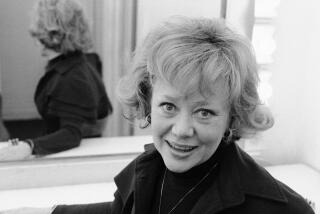AN APPRECIATION : Audrey Hepburn: Good Night, Sweet Princess : Movies: Though her filmography is short, her choices were as tasteful as her enchanting persona.
- Share via
No Hollywood star ever seemed quite so unlike the usual Hollywood expectations of a movie goddess as Audrey Hepburn, who died on Wednesday at the age of 63 after a brief, fierce battle with colon cancer.
She was indubitably a Hollywood star, whose fame and reputation were made in Hollywood films (wherever they were photographed). Yet she was a European by birth and inclination, and the fact that her mother was a Dutch baroness seems to have bequeathed her the quiet assurance that is in-born rather than acquired.
She reminded the men in her audiences (long distracted by the show business insistence that beauty could be measured in inches) that a woman’s true attractiveness was better revealed in her grace, composure and charm and those qualities of intelligence and honesty that, in Hepburn, the camera perceived by a kind of spiritual X-ray.
Her beauty was astonishing. The eyes were large and thoughtful, but capable, too, of most wonderful merriment. Hepburn was, in fact, one of the screen’s most affecting comediennes, and it was no accident that she received an Oscar for “Roman Holiday,” which she made only two years after her debut in a very minor role in “Laughter in Paradise” in 1951. In Rome she played a princess in disguise, which indeed she often seemed to be.
Relative to most of the star actresses of her generation, her filmography is very short, yet there is hardly a film on it that was unworthy of her talent or that smacks of studio pressure or financial thirst. Her choices were as tasteful as her persona.
Still the roles reflect an impressive range of challenges, from the giddy amusement of her Hays Code-laundered version of Truman Capote’s call girl Holly Golightly in “Breakfast at Tiffany’s” to the autumnal melancholy of “Robin and Marian”--that curious imagining of the last days of Robin Hood and his Maid, with Sean Connery as the crusader at twilight.
Her other characterizations were as various as the blind wife under siege in “Wait Until Dark,” the troubled sister in “The Nun’s Story,” the delicious partner to Fred Astaire in “Funny Face” and indeed her Natasha to Henry Fonda’s Andrei in King Vidor’s sometimes underrated “War and Peace” in 1956.
The general rage at Jack Warner for not having cast Julie Andrews in “My Fair Lady” (a decision that reflected Hollywood conventional wisdom at its most dubious) tended to obscure the fact that Hepburn acted a charming Eliza Doolittle, even if she did not sing. It was an irony that I suspect did not escape Hepburn.
Like the most popular of film stars always, Hepburn was admired equally by men and women. If she convinced the men to think freshly about what they should find desirable in women, I don’t doubt that women (envious, it might be, of her beauty) could identify with her independent spirit and her clear sense of herself and her own worth.
It was entirely in character that Hepburn’s last appearance on the public stage was as a representative of UNICEF, reporting, with an anguish obviously deeply felt, on the human misery she had witnessed first-hand in Somalia.
Kenneth Tynan, in a much-quoted tribute, once remarked that what men saw in other women when they were drunk they saw in Greta Garbo when they were sober. The same could be said of Audrey Hepburn. And while moments from her films will certainly stay in mind, what memory will probably retain longest are the still images of her--the matchless beauty, the ravishing smile, the effortless high style, the eyes full of wisdom and amusement, the impression of a woman both elegant and warmly human.
More to Read
Only good movies
Get the Indie Focus newsletter, Mark Olsen's weekly guide to the world of cinema.
You may occasionally receive promotional content from the Los Angeles Times.









